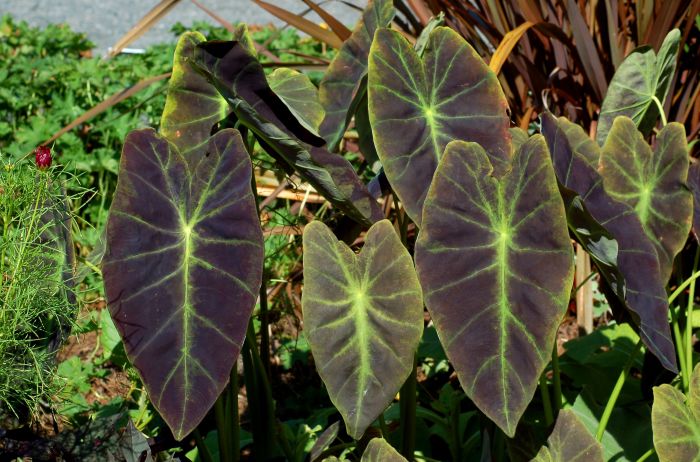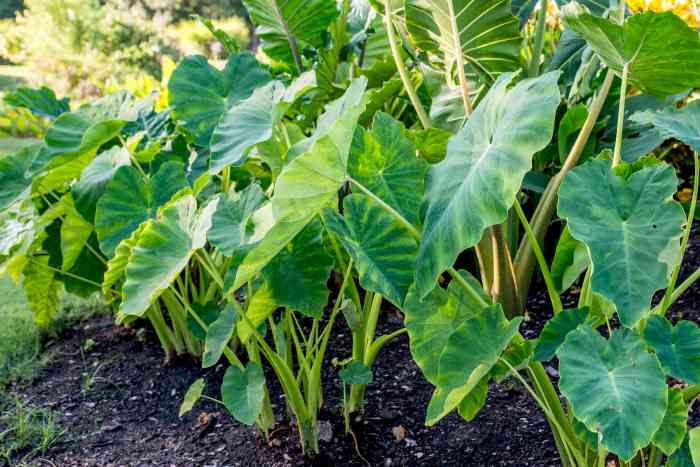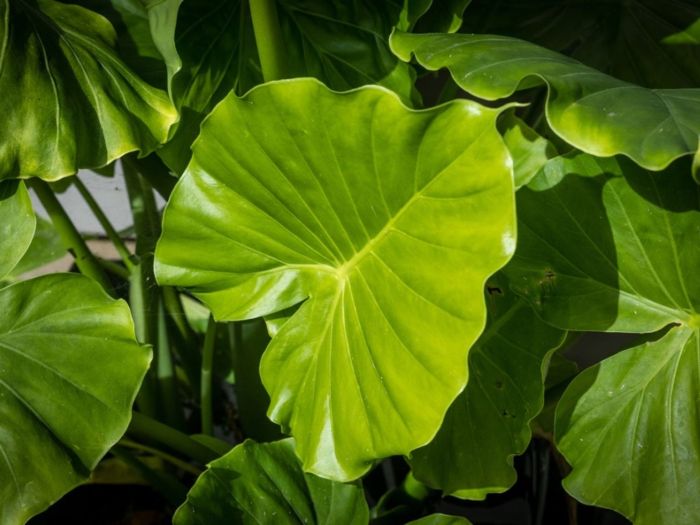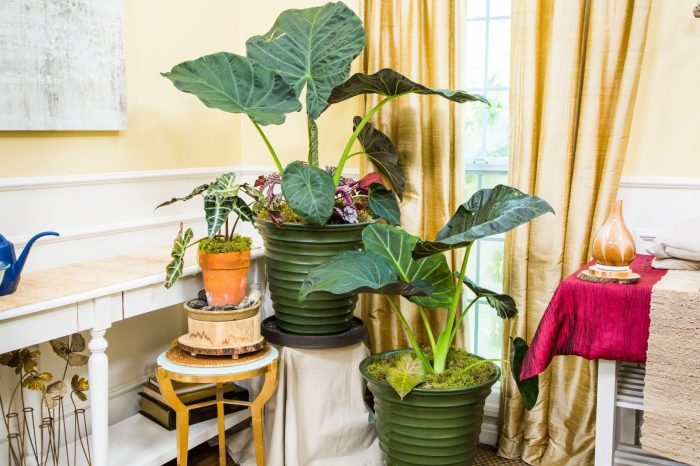How to care for elephants ear plant – Discover the secrets to thriving elephant ear plants with our comprehensive guide. Delving into the intricacies of their care, we unveil the optimal conditions, propagation techniques, and troubleshooting tips to ensure their vibrant growth.
From understanding their ideal lighting and watering needs to managing pests and diseases, this guide empowers you with the knowledge to cultivate magnificent elephant ear plants that will grace your home or garden.
Plant Care Basics

Elephant ear plants, known for their dramatic foliage, thrive when provided with optimal growing conditions. Understanding their specific needs for light, water, and humidity is crucial for their well-being.
Lighting Conditions
Elephant ear plants prefer bright, indirect light. They can tolerate some direct sun, but excessive exposure can scorch their leaves. Avoid placing them in areas with low light, as this can lead to stunted growth and poor leaf development.
Watering Frequency and Techniques
Water elephant ear plants regularly, especially during the growing season. Allow the top inch of soil to dry out before watering again. Overwatering can lead to root rot, while underwatering can cause wilting and stunted growth. Use lukewarm water and water deeply, allowing the water to reach the roots.
Avoid getting water on the leaves, as this can promote disease.
Humidity Levels
Elephant ear plants thrive in humid environments. If the air in your home is dry, consider using a humidifier or placing the plant on a tray filled with pebbles and water. The evaporating water will increase the humidity around the plant.
Fertilizing and Soil Management

Elephant ear plants thrive with regular fertilization and proper soil management. Understanding the appropriate fertilizer type, application schedule, and ideal soil composition is crucial for optimal growth and aesthetics.
Fertilization
Elephant ear plants benefit from a balanced liquid fertilizer applied every two weeks during the growing season. A 10-10-10 NPK ratio fertilizer is ideal, providing equal amounts of nitrogen, phosphorus, and potassium.
Soil Management
Elephant ear plants prefer well-draining, moist soil rich in organic matter. Amend the soil with compost or manure to improve fertility and drainage. The ideal pH range for elephant ear plants is between 6.0 and 6.5.
Elephant ear plants thrive in warm, humid environments with ample sunlight. Water regularly, allowing the soil to dry slightly between waterings. When potting, use a well-draining soil mix and consider adding Bunnings Plant Baskets to provide support and enhance drainage.
Ensure the pot has adequate drainage holes to prevent waterlogging. Regular misting can help increase humidity levels around the plant.
Propagation Techniques

Elephant ear plants can be propagated through various techniques, including division and stem cuttings. Each method offers unique advantages and considerations, ensuring successful propagation for enthusiasts.
To care for elephants ear plant, ensure adequate sunlight, well-draining soil, and regular watering. For optimal soil health, consider Bunnings Orchid Soil: The Ultimate Guide to Nurturing Your Orchids . Its unique blend of ingredients promotes root growth and moisture retention, crucial for elephants ear plants.
Additionally, fertilize monthly during the growing season to support lush foliage.
Division, How to care for elephants ear plant
Division involves separating established elephant ear plants into smaller sections, each with its own root system. This method is ideal for mature plants that have formed multiple clumps or offsets. The best time to divide elephant ear plants is during spring or early summer when the plants are actively growing.
- Carefully dig up the elephant ear plant and gently shake off excess soil from the roots.
- Identify the natural divisions or offsets within the root system.
- Use a sharp knife or spade to carefully separate the sections, ensuring each division has a portion of the root system.
- Replant the divisions in individual containers or in the garden, ensuring the soil is well-draining and amended with organic matter.
Stem Cuttings
Stem cuttings involve taking a section of a healthy stem from an existing elephant ear plant and rooting it to form a new plant. This method is suitable for both upright and trailing varieties.
- Select a healthy stem that is at least 6 inches long and has several nodes (the points where leaves attach to the stem).
- Remove the lower leaves from the stem, leaving only a few leaves at the top.
- Dip the cut end of the stem in rooting hormone and plant it in a pot filled with a well-draining potting mix.
- Keep the potting mix moist and provide bright, indirect light.
- Roots should develop within 2-3 weeks, and the new plant can be transplanted into a larger container or the garden once established.
Common Pests and Diseases
Elephant ear plants, known for their large, showy leaves, can occasionally encounter pests and diseases. Identifying and addressing these issues promptly is crucial for maintaining the plant’s health and aesthetic appeal.
Pests
Several common pests can affect elephant ear plants, including:
- Aphids:These tiny, sap-sucking insects can cause leaf curling, yellowing, and stunted growth.
- Spider mites:These microscopic pests spin webs on the undersides of leaves, causing stippling and discoloration.
- Thrips:These slender insects feed on plant sap, leading to silvery streaks and distorted leaves.
- Mealybugs:These white, cottony insects attach themselves to leaves and stems, causing yellowing and wilting.
To control pests, use insecticidal soap or neem oil. Regular monitoring and early detection are key to preventing infestations.
To care for an elephant ear plant, ensure it receives ample indirect sunlight and well-draining soil. Water the plant regularly, especially during the growing season, but avoid overwatering. For more information on caring for elephant ear plants and other indoor plants, visit plants bunnings . You can find a wide variety of plants and gardening supplies at Bunnings, making it a great resource for plant enthusiasts.
Diseases
Elephant ear plants are also susceptible to a few common diseases:
- Bacterial leaf spot:This disease causes brown or black spots on leaves, which can eventually merge and kill the foliage.
- Fusarium wilt:This fungal disease causes yellowing and wilting of leaves, starting from the bottom of the plant.
- Rhizome rot:This fungal disease attacks the plant’s underground rhizomes, causing stunted growth, yellowing, and eventually plant death.
To manage diseases, practice good sanitation by removing infected plant parts and avoiding overwatering. Fungicides may be necessary in severe cases.
When caring for elephants ear plants, it’s crucial to provide them with well-draining soil, consistent watering, and bright, indirect light. If you’re looking for stylish and functional pots for your elephant ear plant, consider reading Bunnings Outdoor Ceramic Pots: A Comprehensive Guide to Styling Planting and Care . This guide offers valuable insights on choosing the right ceramic pots and provides tips on styling and caring for your plants.
Troubleshooting Common Issues: How To Care For Elephants Ear Plant

Elephant ear plants are generally low-maintenance, but they can occasionally experience some common issues. By understanding the causes and solutions to these problems, you can keep your elephant ear plants healthy and thriving.
Yellowing Leaves
- Cause:Overwatering or underwatering
- Solution:Adjust watering frequency to meet the plant’s needs.
- Cause:Nutrient deficiency
- Solution:Fertilize the plant regularly with a balanced fertilizer.
- Cause:Iron deficiency
- Solution:Add iron chelate to the soil.
- Cause:Root rot
- Solution:Repot the plant in fresh soil and remove any damaged roots.
Wilting or Drooping Leaves
- Cause:Underwatering
- Solution:Water the plant deeply and regularly.
- Cause:Overwatering
- Solution:Allow the soil to dry out before watering again.
- Cause:Root rot
- Solution:Repot the plant in fresh soil and remove any damaged roots.
Stunted Growth and Leggy Stems
- Cause:Lack of sunlight
- Solution:Move the plant to a brighter location.
- Cause:Nutrient deficiency
- Solution:Fertilize the plant regularly with a balanced fertilizer.
- Cause:Overcrowding
- Solution:Divide the plant and repot it in separate containers.
Final Review
With a deep understanding of elephant ear plant care, you can now confidently provide the optimal environment for these stunning plants to flourish. Remember, patience and attention to detail are key to unlocking their full potential, and the rewards will be an abundance of lush, eye-catching foliage that will transform your space.
Expert Answers
How often should I water my elephant ear plant?
Water when the top inch of soil feels dry to the touch, usually once or twice a week.
What is the ideal temperature range for elephant ear plants?
They prefer warm temperatures between 65-85°F (18-29°C).
How can I propagate elephant ear plants?
You can divide the plant or take stem cuttings in spring or summer.